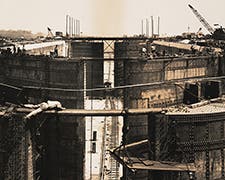People Dying Every Day
“Early in June [1910] the Chief Quartermaster became alarmed for the safety of his house on the point of the hill…the slide having extended to within about 90 feet of the building.” - A.B Nichols

Steam shovel #258 and loaded flat cars caught in a slide at Culebra, May 29, 1913. Image source: Nichols, Aurin Bugbee, and Tirzah Lamson Nichols. Panama Canal Collection, 1846-1923 (bulk 1906-1914). Vol. 48b, Oct. 1912, p. [65].
From 1907 through 1914, the Canal experienced over 100 slides. Some came without warning, burying workers and equipment and completely blocking the Canal.
Huge landslides, mainly in Culebra Cut, confounded Canal engineers. The slides were of two types. Gravity slides were caused by porous, saturated material sliding down slopes of firmer, more impervious rock or clay. Deformation slides were caused by unstable rock brought down primarily by overly-steep slopes. Not only did slides dump millions of cubic yards of material back into the Canal, some slides created bulges that pushed up material from below the bed of the Canal. As the Cut deepened and the slopes grew steeper, the slides grew larger and more frequent. The only remedy was to excavate a wider channel and make the slopes less steep. Millions more cubic yards would need to be cleared from the slopes.
Though most landslides crept slowly into Culebra Cut, they could sometimes come without warning and bury men and equipment. The screams of accident whistles brought workers running, heading onto risky ground to try to dig out workers that might still be alive.
In October 1907, a slide at Cucaracha in the Cut was the first the Americans experienced. After days of heavy rain, a mud avalanche fell into the Cut. More mud continued to move, glacier-like, at an average of 14 feet a day for 10 days. In all, 500,000 cubic yards of material slid into the Cut. Slides continued to bedevil Lt. Col. David Gaillard, the engineer in charge of the Culebra Cut, throughout the Canal construction. In January 1912, when yet another destructive slide at Cucaracha completely blocked the Canal, Gaillard, at his wits end, asked Chief Engineer Goethels what to do. Goethels replied, “Hell, dig it out again.”



